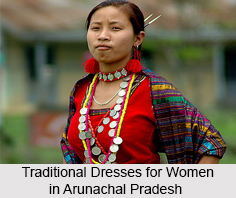 Traditional Dresses of the different tribes of Arunachal Pradesh are endowed with fascinating vibrant colours and myriad patterns, characteristic of tribal culture. It signifies their aesthetic taste and zeal for embellishment. The traditional dresses of Arunachal Pradesh are very spectacular. People here love their traditional costumes and are proud to showcase them on each and every occasion that comes across.
Traditional Dresses of the different tribes of Arunachal Pradesh are endowed with fascinating vibrant colours and myriad patterns, characteristic of tribal culture. It signifies their aesthetic taste and zeal for embellishment. The traditional dresses of Arunachal Pradesh are very spectacular. People here love their traditional costumes and are proud to showcase them on each and every occasion that comes across.
Traditional Dresses for Men in Arunachal Pradesh
In accordance with the geographical circumstances of the region, men secure themselves with helmets made from cane, bear and deer skin. The Hill Miris inhabiting the lower Kamla valley look attractive in their costume. They tie the hair in a knot just above the forehead. The Sherdukpen, inhabiting south of Bomdila in the Tengapanai valleys, bear striking resemblance with their fellow Buddhist community, the Monpas. The usual apparel of Sherdukpen men folk is a sleeveless silk material, with its two edges pinned at the shoulder region. The costume is normally knee-long. The hallmark of their dress code is the "Gurdam" skull-cap smeared with yak"s hair.
 The Tangsa men wear green lungi, proficiently seamed in with matching yellow, red and white yarns. A sleeveless shirt, acts as the upper garment. By custom, the Apatani men, make a knot of their hair just above the forehead. The local name of this hairstyle is as "Piiding" and the brass rod used in the creation of this knot is known as "Piiding Khotu".
The Tangsa men wear green lungi, proficiently seamed in with matching yellow, red and white yarns. A sleeveless shirt, acts as the upper garment. By custom, the Apatani men, make a knot of their hair just above the forehead. The local name of this hairstyle is as "Piiding" and the brass rod used in the creation of this knot is known as "Piiding Khotu".
Traditional Dresses for Women in Arunachal Pradesh
Accessories are a must for any woman in Arunachal Pradesh. The Monpa females beautify themselves with silver rings, earrings cut from bamboo bits and appended with red beads or lovely turquoises. Another popular dress item is a cap, endowed with a fascinating peacock feather. The women of Hill Miris wear attractive "crinoline of cane rings" which serves the purpose of a blouse. The women sect of Sherdukpen dresses themselves in a collarless and sleeveless garment, stretching from the shoulders to the knees. Added to this, a full-sleeved jacket with nice embroidery and waist cloth called "Mushaiks" is worn above the patent robe. The women often tie their hair into a bun at the back.
Tangsa women put in a very attractive looking woven petticoat, along with a linen blouse to top it. Miji women, living in the West Kameng and East Kameng districts, exhibit simplicity as well as refinement in their costume. The ankle-long white cloak gives the Miji women an immaculate look. And the final touch is given by an ornate red jacket. The women arrange their tresses into a ball called "Dilling" on the head-top. A brass skewer known as "Ading Akh" is often passed through the Dilling, in a horizontal direction.





















